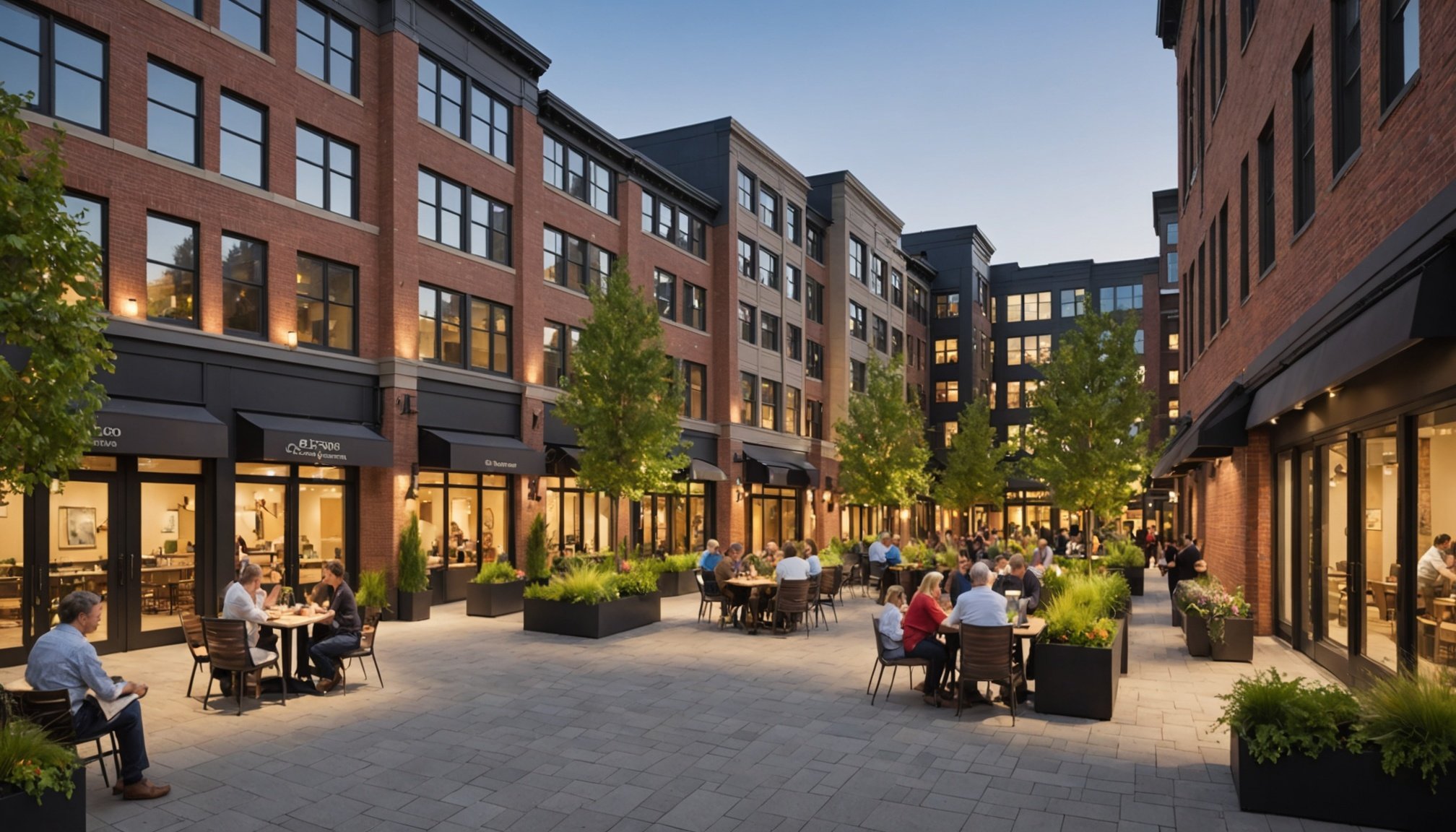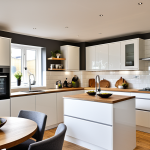Understanding Mixed-Use Developments
Mixed-use developments are integral to urban planning in contemporary cities. These developments blend residential, commercial, cultural, and sometimes industrial spaces within a single area, promoting vibrant and diverse communities. The evolution of mixed-use developments highlights a shift from traditional, single-use zoning to an approach that prioritizes multifunctionality and community integration.
Historically, cities have separated land uses into distinct zones, but this model has given way to more integrated urban planning. This evolution is driven by the need to reduce sprawl and enhance community interaction. The emphasis is on creating environments where people can live, work, and play in close proximity, thus facilitating a more cohesive community fabric.
Also read : Unlocking Urban Potential: Creative Approaches to Revitalize and Transform Abandoned Spaces
A critical aspect of successful mixed-use developments is their impact on urban infrastructure and design. They are designed to encourage walking, cycling, and the use of public transport, reducing reliance on cars. This approach not only supports environmental sustainability but also enhances social interaction and economic activity.
Community integration plays a vital role in planning such developments. Through thoughtful design and engagement processes, these spaces aim to foster a sense of belonging and community ownership. By blending living spaces with commercial and recreational facilities, mixed-use developments can effectively meet diverse community needs.
Additional reading : Revolutionizing Instant Property Valuations with Cutting-Edge AI Technology
Economic Benefits of Mixed-Use Developments
Understanding the economic advantages of mixed-use developments is pivotal for stakeholders. These projects tend to offer enhanced property values, appealing to investors by providing significant returns. This happens because such developments create a vibrant environment, attracting diverse demographics seeking the convenience of accessing various amenities without the hassle of lengthy commutes. These environments, by offering entertainment, retail, and residential options in proximity, raise property values due to their desirability.
In terms of investment return, mixed-use projects often have a higher yield compared to single-use assets. The blended nature of their offerings enables them to capture a broader economic base and mitigate risks associated with reliance on a single type of tenant or consumer group. When a community combines residential, commercial, and recreational spaces, it has the potential to build a self-sustaining economy, further maximizing investment returns.
Additionally, by attracting diverse businesses and customer bases, these developments support local employment and stimulate economic growth. Mixed-use areas often become focal points for commerce and community activity, drawing in businesses that benefit from an already established footfall. Such synergy not only enhances the economic vitality of a region but also strengthens the fiscal health of the broader community ecosystem.
Strategies for Effective Community Engagement
Effective community involvement is crucial for the success of mixed-use developments. By fostering active stakeholder participation, developers can ensure that projects meet the needs and desires of local residents and businesses. A proactive approach is essential, involving various strategies.
Engaging Local Residents
Involving residents through regular community meetings and workshops is key. These gatherings provide an opportunity to present plans, collect input, and foster a sense of ownership. Local residents should feel heard and valued, enhancing overall community satisfaction.
Collaboration with Businesses
Partnering with local businesses can create a mutually beneficial environment. Businesses often provide valuable insights and resources, contributing to a development’s vitality. Engaging businesses ensures developments cater to both residents and commercial stakeholders, enhancing overall viability.
Utilizing Surveys and Feedback
Implementing robust feedback mechanisms through surveys or digital platforms ensures continuous dialogue with the community. Collecting feedback enables developers to adapt and refine plans to better serve community interests. A transparent process encourages trust and long-term engagement, maximizing the development’s potential for success. This strategy helps to adapt plans continually in line with community needs, ensuring long-term project relevancy and acceptance.
Design Elements that Foster Harmony
Exploring design strategies is essential for fostering harmony in mixed-use developments. Multifunctional spaces are key to encouraging interaction, bringing together diverse community elements within a shared environment. Such spaces often blend residential, commercial, and recreational areas to enhance the social fabric of a community. By creating an environment that meets various lifestyle needs, these developments promote a sense of togetherness.
Integrating Green Spaces
Incorporating green spaces and public areas is crucial for public enjoyment and wellbeing. These spaces serve multiple purposes, from offering relaxation spots to acting as gathering areas for community events. The presence of parks and gardens can significantly increase the overall appeal and functional quality of a mixed-use area, providing residents with essential contact with nature.
Architectural Integration
Effective architectural integration plays a pivotal role in blending residential and commercial elements seamlessly. A well-thought-out design informs the layout, ensuring that different areas complement each other functionally and aesthetically. Designs that embrace open-plan concepts and the flow of natural light create welcoming, vibrant spaces that cater to contemporary urban needs. Successful architectural integration not only enhances usability but also contributes to the economic sustainability of the project.
Case Studies of Successful Mixed-Use Developments
Exploring best practices through real-world examples helps identify the ingredients for thriving mixed-use projects. These success stories illustrate how innovative approaches can achieve harmonious community integration and economic vitality.
A prominent example is Hudson Yards in New York City. This development showcases a blend of residential, cultural, and commercial spaces, fostering vibrant community life. It integrates green public spaces and state-of-the-art infrastructure, setting a benchmark in urban planning.
Another example is the Battersea Power Station development in London. Anchored by its iconic architecture, the site revitalizes the area by seamlessly weaving together homes, retail spaces, and offices. This case study highlights the power of innovative design in creating a mixed-use development that respects its historical context while serving contemporary urban needs.
Furthermore, the success of Santana Row in California demonstrates how thoughtfully designed public spaces can boost community interaction and economic growth. The integration of boutique shopping centers, residential areas, and entertainment venues creates a self-sustained ecosystem appealing to a diverse demographic.
Lessons learned from these projects emphasize the necessity of balancing residential and commercial needs through strategic planning and leveraging architectural creativity. Implementing such innovative approaches ensures successful mixed-use developments that enrich urban landscapes.
Balancing Commercial and Residential Needs
Navigating the balance between commercial and residential needs is key in mixed-use developments. This intricate dance ensures spaces cater to businesses while simultaneously providing community living solutions.
Zoning laws play a pivotal role. They guide the integration of mixed-use zones by dictating terms on how spaces can be shared. Adhering to these regulations can be challenging but is crucial for harmony. Understanding these laws helps developers map out functional spaces that accommodate both residences and businesses efficiently.
A strategic mixed-use balance can be achieved by identifying key stakeholders and their interests. This involves aligning goals between local authorities, developers, residents, and business owners. Gathering diverse insights allows creating spaces that satisfy commercial profitability while ensuring quality community life.
Finally, implementing strategies that mediate competing interests is essential. For instance, providing enough parking without compromising public green spaces or ensuring noise levels from commercial activities do not disturb residential areas. When businesses and residents benefit equally, mixed-use developments thrive, providing sustainable urban landscapes. Engaging community input through surveys and stakeholder meetings can further refine these strategies, aligning with broader community objectives while enhancing urban vitality.
Future Trends in Mixed-Use Development
Emerging trends in urban planning are reshaping the future of mixed-use developments, with a strong focus on sustainability and urban regeneration. As cities grow, the demand for spaces that accommodate diverse activities sustainably becomes imperative. One such trend is the integration of smart technologies, which enhance efficiency through intelligent building management systems and sustainable resource use. By utilising IoT devices and smart grids, these developments significantly reduce environmental footprints while improving user experience.
Sustainability in mixed-use developments also emphasizes energy efficiency and eco-friendly building materials. Future-oriented projects increasingly incorporate renewable energy sources, such as solar panels and wind turbines, alongside rainwater harvesting systems. These innovations not only offer environmental benefits but also appeal to eco-conscious residents and investors.
Urban regeneration plays a crucial role in revitalizing underutilized areas by transforming them into vibrant, multifunctional communities. The development of such areas often includes preserving historical architecture to maintain cultural heritage, while imbuing a modern twist for contemporary lifestyles.
Predictions for the future landscape highlight an increase in vertical mixed-use developments, especially in densely populated urban centers. This vertical approach maximizes land use, supporting a dynamic mix of commercial, residential, and recreational spaces stacked in a single structure, epitomizing efficient urban living.








